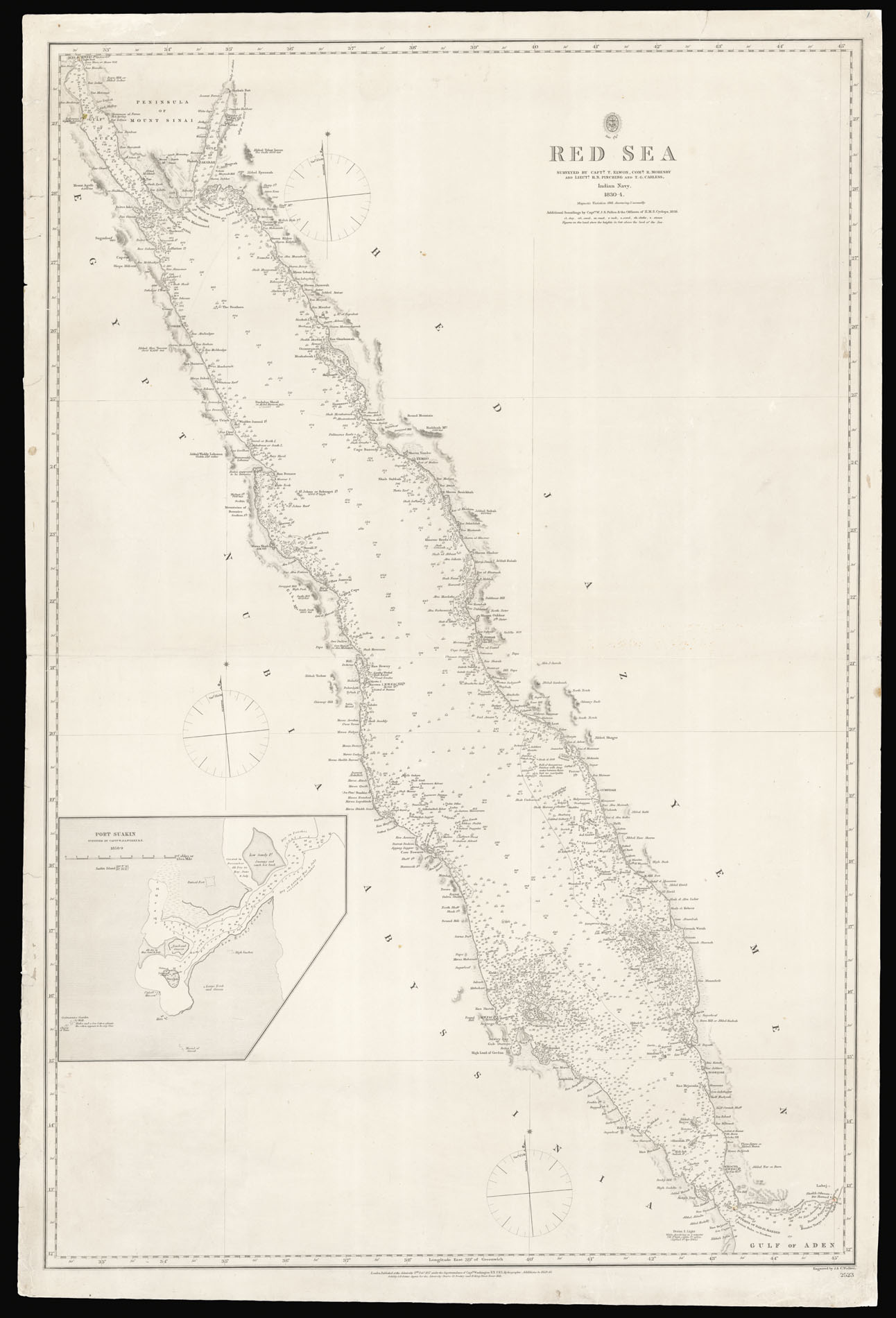

"The beautiful maps of the Red Sea... will ever remain permanent monuments of Indian Naval Science"
By MORESBY, Commander R[obert]; and CARLESS, Lieutenant T. G. ELWON, T. Captain; and PINCHING, Lieutenant H. N. , 1857
£1,500
The Red Sea surveyed by Captn. T. Elwon, Comr. R. Moresby and Lieuts. H.N. Pinching and T.G. Carless, Indian Navy. Additional Soundings By Captain W.J.S. Pullen... H.M.S. Cyclops 1858.
- 作者: MORESBY, Commander R[obert]; and CARLESS, Lieutenant T. G. ELWON, T. Captain; and PINCHING, Lieutenant H. N.
- 出版地: London,
- 出版商: The Admiralty,
- 发布日期: 1857 (additions to 1861).
- 物理描述: Engraved chart, inset view of Port Suakin, lighthouses marked in yellow, few nicks and tears to margin, skilfully repaired, not affecting image.
- 方面: 995 by 665mm. (39.25 by 26.25 inches).
- 库存参考: 14360
笔记
This rare chart of the Red Sea is the result of the perilous surveying voyages undertaken by the sailors of the Indian Navy. In order to chart the dangerous waters of the Red Sea, a two-ship hydrographic expedition was launched under Captain Thomas Elwon and Commander Robert Moresby in 1829. Over the course of the following three years, the teams aboard the Palinurus and Benares surveyed the coastline and waters to ensure that the route from Europe to the East Indies was viable for new steam vessels. The diaries kept by crew members offer direct insight into their experiences in the Red Sea. As well as geographical and navigatory details, such as anchorages, fuel supplies and obstacles, these journals tell of the diseases that plagued both ships. One of the principal assistants in the task, Lieutenant Pinching, actually died in the sweltering African climate and was buried on the land off of the Gulf of Aden, shown in the lower right corner of the chart. More happily, Moresby's own diary celebrates the abundance of the mainland, where "provisions were plentiful and good—oranges, pears, apples, plums in season. And there were plenty of fine cabbages!". Also recorded are the techniques used in the surveying itself, which included using local boats and pilots to chart dangerous coastal areas, and on one occasion, Moresby is said to have sprung up the rigging to confirm that a distant mass was actually a reef.
The charts produced from this surveying expedition proved of great importance throughout the rest of the nineteenth century, to such an extent that in his work, 'First Footsteps in East Africa', the explorer Richard Burton, states that they "will ever remain permanent monuments of Indian Naval Science, and the daring of its officers and men". The present chart shows depth with isolines and soundings, relief with hachures and spot heights, and identifies key features such as lighthouses and harbours. Port Suakin is shown in particular detail on an inset map because of its importance as a British colonial base; it is from Suakin that Kitchener led a contingent of the Egyptian Army in the 1880s. Although the chart is, in general, highly accurate, the reef of El Akhawin in the Northern part of the Sea is surprisingly misplaced, and its position was not correctly established for several decades. The imprint in the lower right corner identifies the engraving of this chart as the work of John and Charles Walker. Walker Cartographers had been responsible for naval charts since the British Hydrographic Office was established in the late eighteenth century, and subsequently produced numerous charts of the colonies.
Rare
The charts produced from this surveying expedition proved of great importance throughout the rest of the nineteenth century, to such an extent that in his work, 'First Footsteps in East Africa', the explorer Richard Burton, states that they "will ever remain permanent monuments of Indian Naval Science, and the daring of its officers and men". The present chart shows depth with isolines and soundings, relief with hachures and spot heights, and identifies key features such as lighthouses and harbours. Port Suakin is shown in particular detail on an inset map because of its importance as a British colonial base; it is from Suakin that Kitchener led a contingent of the Egyptian Army in the 1880s. Although the chart is, in general, highly accurate, the reef of El Akhawin in the Northern part of the Sea is surprisingly misplaced, and its position was not correctly established for several decades. The imprint in the lower right corner identifies the engraving of this chart as the work of John and Charles Walker. Walker Cartographers had been responsible for naval charts since the British Hydrographic Office was established in the late eighteenth century, and subsequently produced numerous charts of the colonies.
Rare
参考书目
- Burton, 'First footsteps in East Africa or an exploration of Harar
- ', (1894)
- Moresby, 'A Record of Life and Service in the British Navy for a Hundred Years', (Murray, London 1909)
- Searight, 'The Charting of the Red Sea', (History Today, 2003)
- Wellsted, 'Travels in Arabia', (Murray, London 1838).
图片库
/
 地图
地图  地图集
地图集  珍本
珍本  版画
版画  天文仪器
天文仪器 










